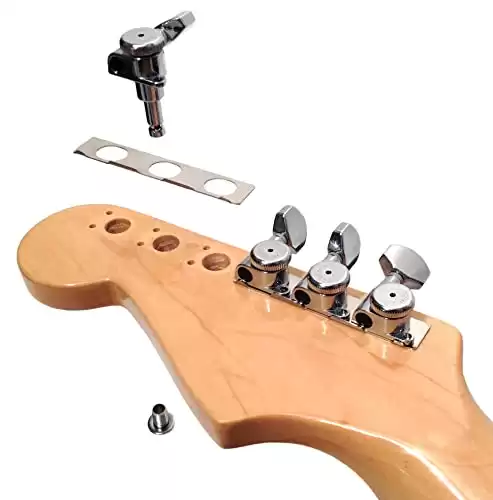Most musicians don’t give a second thought to string trees unless a problem develops with their guitars. Even then, many players haven’t heard of this small, but essential component.
When there is insufficient pressure on a string because of the way it sits in the nut, the guitar sounds more like a sitar.
You can also cause too much downward pressure with string trees, creating premature wear and tear on the affected nut slots. This problem even creates some tuning concerns.
If you have a whammy bar, some string trees interfere with a return to pitch after release.
That’s why it helps to know if adding this part can make your instrument happier or create more problems. This guide will take you through everything you need to know about string trees.
Guitar Shop 101: Happy Little (String) Trees
String trees are an underrated part of playing the guitar. These tiny additions often go unnoticed, but they play a vital role for flat, Fender-style headstocks. The string trees secure the first two or four strings between the tuners and the nut. Some players install three of them to prevent buzzing.
String trees might be tiny, but they can also dramatically improve the quality of a guitar’s sound.
Whether you play the electric guitar or bass, the primary function of the string tree is to deliver the correct levels of downward pressure on the strings. This action prevents the individual lines from buzzing or rattling within the nut slot.
By placing the pressure on the headstock, the guitar can sustain each note correctly when played with an open style.
When an open string doesn’t have a secure seat in its slot, it becomes pinned like it would when a finger presses it against a fret. That means your notes would be as clear or as loud as they should be.
Whether a guitar or bass requires string trees is based on the headstock construction. If you’re playing a Gibson instrument, this part tilts back at an angle from the fretboard.
That design is enough to create the downward pressure needed to keep everything in each slot while routing toward the tuner.
If your guitar uses a six-in-a-row design on the headstock with a flat addition, you’ll need the downward pressure from the string trees to achieve the sound you want.
The most common guitars that need this tiny part are Teles and Strats. Any design that copies this look from other manufacturers can also benefit from its inclusion.
How to Insert a String Tree for the First Time
If you need to install a string tree on a guitar headstock that has never had one before, the first step is to get everything lined up appropriately.
You’ll want to string up the instrument before laying the new tree on the corresponding strings. The placement is approximately halfway between the nut and the closest tuner.
You’ll need to confirm that the strings are lined up evenly with the tree in place. Once you’re confident in the placement, press down on the product so that the screw makes a small indentation on the headstock.
Since this step can damage the guitar when done incorrectly, you’ll want to double-check every measurement before pressing down to create the indentation.
It might be tempting to place the string tree and attach the screw in a single step. That’s not a great idea because the damage risks rise exponentially.
Do not install a string tree on any guitar without creating a pilot hole for the screw first.
You’ll drill the pilot hole in the exact spot where you created the indentation. The bit used for this step should be one size smaller than the screw for the string tree.
Go slowly while creating this guide for the screw. It won’t take much for the drill bit to push through the entire headstock if you’re not careful. The screw only needs a fraction of an inch to be stable in its placement.
Before placing the screw to secure the string tree, it helps to add some lubrication to the threads. A little soap often works well, but you can also try things like candle wax or WD-40.
If your guitar has a hard maple headstock, inserting the screw for the string tree requires some significant skill to avoid damaging the instrument. An experienced luthier can help you with this work if you don’t have the right tools available. Some shops might also offer a certified repair tech who can help.
What Are the Different Types of String Trees?
When your guitar needs string trees installed to create enough break, you’ll find that three common styles are typically available. Each one has some unique advantages to consider.
| Butterfly-Style String Trees: | • I love this option because the installation process is super simple. • You take a Philips-head screwdriver after drilling the pilot hole to install the unit. • That’s it! The “wings” prevent the strings from slipping, while the size is small enough that it doesn’t add weight to the instrument. |
| Barrel-Style String Trees: | • My first electric guitar was a Squier with the six-in-a-row configuration. • The tuners stood tall, which meant this style looked more cohesive when installed. • You need to be careful when working with this design because the screw goes above the placement point. |
| Disc-Style String Trees: | • When you prefer a low-profile option for your guitar, this design works the best. • It’s about half the size of the barrel design without sticking up like the butterflies. • That makes them a little tougher to place, but they also don’t make the same visual impact. |
Most string trees are made from metal. I prefer the butterfly because of its installation ease, but the disc style is a close second.
I feel that the barrel-style option makes the instrument a little top-heavy, even though the weight additions are negligible. It just feels different.
The one thing I would recommend is that you install graphite string trees if you use lots of tremolo or bending.
When the strings scrape against the tree, it creates more friction that causes pitch return loss. You can even experience problems with tuning.
You can install a roller-style option as an alternative. This design is like the barrel option, but it presses the screw straight down instead of having the retainer be below the installation point.
What If I Don’t Want to Damage My Guitar?
Whether you’ve finished a build or you want to avoid the look of a string tree on your guitar, there are a few alternative ways to reduce the unwanted buzz that comes from the instrument.
The primary option is to use staggered tuners.
When you have the Hipshot Grip-Lock inline tuners, you’ll receive a universal mounting plate that works for Strats, Teles, and the other instruments that copy that design.
I love the vintage 8.5mm size and that you don’t need to modify your headstock to use this option.
With the Hipshot locking tuners, you’ll receive a thumb and pin wheel system that clamps onto the string.
That means you can avoid the wrapping and string trees for good. The design also incorporates the staggered post option to give each note the ideal break angle.
Another option is to take a low winding approach. Everyone has a way they prefer when stringing a guitar. Some people really love having 4-6 wraps around the tuners to give the instrument a beefy feel.
If you’re playing a Tele or Strat, it is often better to keep it to two wraps. That means you might need to trim the strings before the installation.
You’ll also find that more windings make it harder to swap out your strings when you want to try something new.
The goal here is to avoid having the strings wind back up the post over the existing wraps you’ve created. That’s because the upward travel changes the break angle over the nut, creating the need for the tree.
The best way to determine the correct length is to measure two tuning posts beyond the installation point and pull back.
Since the six-in-a-row formation creates different sizes, the re-stringing process will take longer than usual.
It’s worth the extra effort if your goal is to avoid placing a screw in the instrument’s headstock.
Although you can achieve more windings with the thinner strings, it’s still better to keep everything to two or three – except for the third, fourth, and fifth. Adding a few more windings here can give you some extra angles to use.
Every guitar is a little different, which is why it’s tough to be exact. When in doubt, have your luthier or an experienced professional consult on the project.
A Final Thought on Using String Trees
String trees are no longer needed on some Tele or Strat guitar designs. Manufacturers are now offering locking tuners with staggered posts to create the required string angle with the six-in-line headstock option. Depending on the geometry, these tuners might eliminate the need to modify altogether.
In most cases, string trees become unnecessary with staggered tuners. The only way to know for sure if you need string trees on your Tele or Strat (or similar design) is to install them to discover how your guitar sounds.
Once you give the guitar a strum, you should hear the appropriate sustain and note quality. If you still get a hum that makes the instrument sound more like a sitar, that means the string trees must get installed.
Even with staggered tuners, some guitars have a shallow angle for the top strings that require this small component.
I always gauge my decision based on how the guitar sounds with the tuners first. If it feels good, I leave things along – even if there is a bit of vibration in there. That way, I’m not modifying the headstock with a new hole in it for a tree to create downward pressure.
When the instrument has too much buzz, that’s when I grab the string trees to install.
I highly recommend working with an experienced luthier if you’ve never installed string trees before. The cost might be a little higher, but the work is much cleaner.


